tow CHEVROLET CAMARO 1973 2.G Owners Manual
[x] Cancel search | Manufacturer: CHEVROLET, Model Year: 1973, Model line: CAMARO, Model: CHEVROLET CAMARO 1973 2.GPages: 84, PDF Size: 32.64 MB
Page 10 of 84
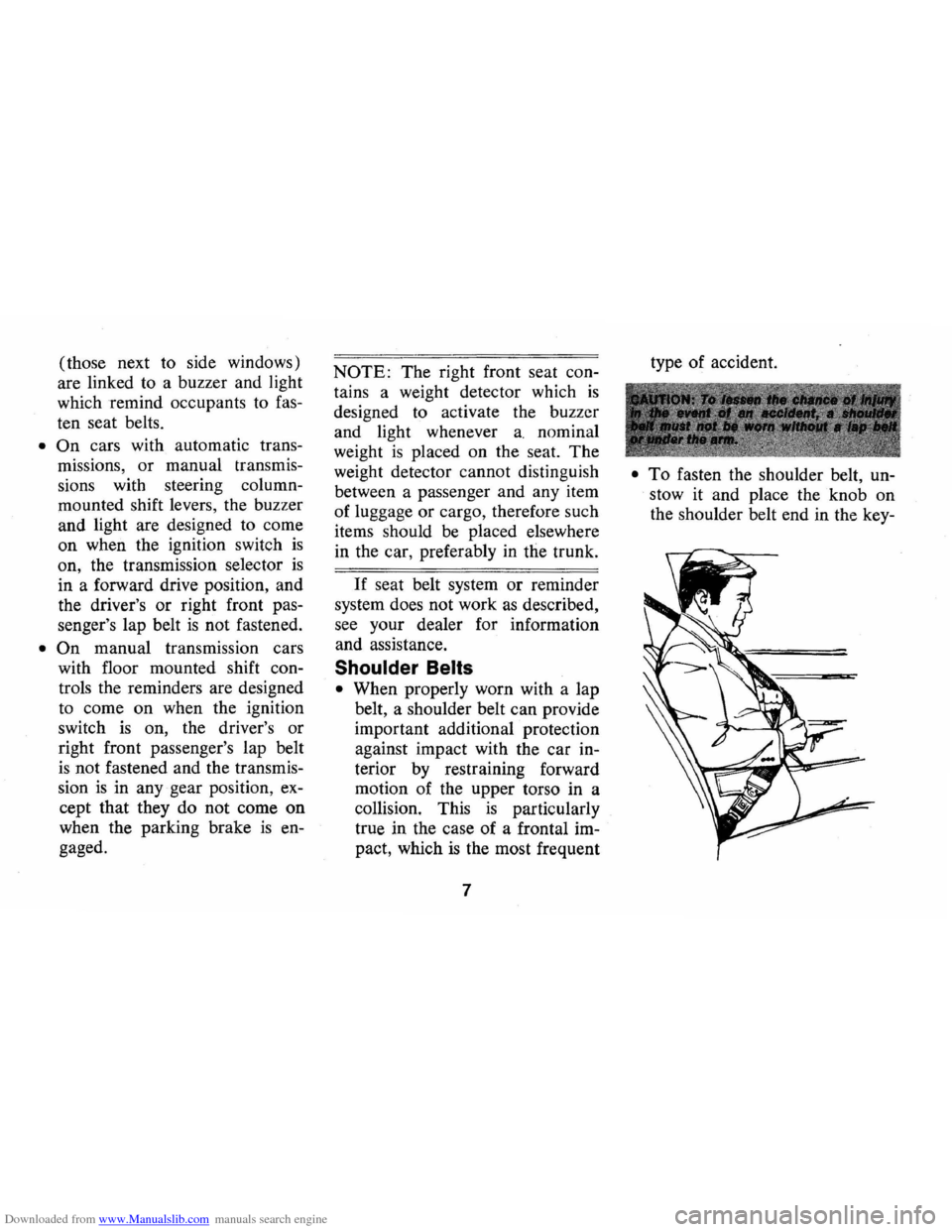
Downloaded from www.Manualslib.com manuals search engine (those next to side windows)
are linked to a buzzer and light
which remind occupants to fas
ten seat belts.
• On cars with automatic trans
missions, or manual transmis
sions with steering column
mounted shift levers, the buzzer
and light are designed to come
on when the ignition switch
is
on, the transmission selector is
in a forward drive position, and
the driver's or right front pas
senger's lap belt
is not fastened.
• On manual transmission cars
with floor mounted shift con
trols the reminders are designed
to come on when the ignition
switch
is on, the driver's or
right front passenger's lap belt
is not fastened and the transmis
sion
is in any gear position, ex
cept that they do not come
on
when the parking brake is en
gaged.
NOTE: The right front seat con
tains a weight detector which
is
designed to activate the buzzer
and light whenever
a. nominal
weight
is placed on the seat. The
weight detector cannot distinguish
between a passenger and any item
of luggage or cargo, therefore such
items should be placed elsewhere
in the car, preferably
in the trunk.
If seat belt system or reminder
system does not work
as described,
see your dealer for information
and assistance.
Shoulder Belts
• When properly worn with a lap
belt, a shoulder belt can provide
important additional protection
against impact with the car in
terior by restraining forward
motion of the upper torso in a
collision. This
is particularly
true in the case of a frontal im
pact, which
is the most frequent
7 type
of accident.
• To fasten the shoulder belt, un
stow it and place the knob on
the shoulder belt end in the key-
Page 11 of 84

Downloaded from www.Manualslib.com manuals search engine hole on the lap belt latch plate.
(The latch is designed so that
this attachment
can only be com
pleted before fastening the lap
belt.) Tilt the knob
as neces
sary, to pass it through the slot.
Pull the knob firmly upward to
seat it at the narrow end of the
keyhole, then fasten the lap
belt.
• Shoulder belts are lengthened
and shortened
in the same man
ner
as center seat lap belts.
• Shoulder belt should have suffi
cient slack to insert a fist's
width between your chest and
the belt. This can be checked
by inserting a clenched
fist be
tween the belt and your chest
with thumb against chest and
back of hand facing upward.
• When not in use, the shoulder
belt may be stowed by leaving
it attached to the lap belt and
allowing the lap belt to rewind into
its retractor. Take up re
maining slack using the shoul
der belt adjustment feature.
• To completely restow the shoul
der belt, .remove the belt knob
from the keyhole (tilting knob
as necessary). Then restow belt
along roof rail in accord with
illustration. .
When not in use, all loose lap
and shoulder belts should be se
cured to reduce the danger of
the
metal ends striking an occupant in
an accident. When special stowage
provisions are not provided, the
8 loose
ends should be attached to
each other and adjustment
made
to remove the slack in the belt sys
tem. Be sure that belts are not left
in a position where the webbing
or
hardware can be pinched in the
seat structure
or door, and thus
become damaged.
Seat Belt Inspection
• Periodically inspect belts, buc
kles, retractors, and anchors for
damage that could lessen the ef
fectiveness
of the restraint sys
tem.
SHOULDER BELT
STOWAGE
Page 12 of 84

Downloaded from www.Manualslib.com manuals search engine • Keep sharp edges and damaging
objects away from belts.
• Replace belts if cut, weakened,
frayed, or subjected to collision
loads.
• Check that anchor mounting
bolts are tight.
• Have questionable parts re
placed.
• Keep seat belts clean and dry.
• Clean only with mild soap solu
tion and lukewarm water.
• Do not bleach or dye belts since
this may severely weaken belts.
Child Restraint
Children in automobiles · should
be restrained to lessen the risk of
injury in accidents, sudden stops
or other hazardous situations.
General Motors dealers offer re
straint systems designed specific
ally for use with infants. In using
any infant or child restraint
sys
tem, read and comply with all in- stallation
and usage instructions.
All unused seat belts near the
child should be stowed properly to
help prevent them from striking
him in the event of an accident.
Lap belts and shoulder belts with
out storage provisions should have
buckles latched and belts adjusted
to remove slack.
Cars Not Equipped With
Special Child Restraints
If a child is traveling in a vehi
cle not equipped with a General
Motors
inf~mt restraint or other
safe infant or child restraint
sys
tem, . the following precautions
should be taken:
1. Infants unable to sit up by
themselves should be restrained
by placing them in a covered,
padded bassinet which
is placed
crossways in the vehicle (width
wise) on the rear seat. The bas
sinet should be securely re
strained with the regular vehi-
9
cle seat belts. An alternate me
thod
is to position the bassinet
so that it rests against the back
of the front seat, again cross
ways in the vehicle.
2. Children able to sit up by them
selves should be placed on a
seat and lap belted, preferably
in the rear seat. Never allow a
child to stand or kneel on any
seat.
If the child cannot see out
the car windows he should sit
on a firm cushion with the reg
ular lap belt restraining him at
the hips. The cushion should be
as firm as practical and just
high enough to enable the child
to look horizontally out of the
car windows. The use of the
cushion should be discontinued
as soon as the child is old
enough to see out of the car
windows without it.
3. General Motors recommends
that children be restrained
Page 13 of 84
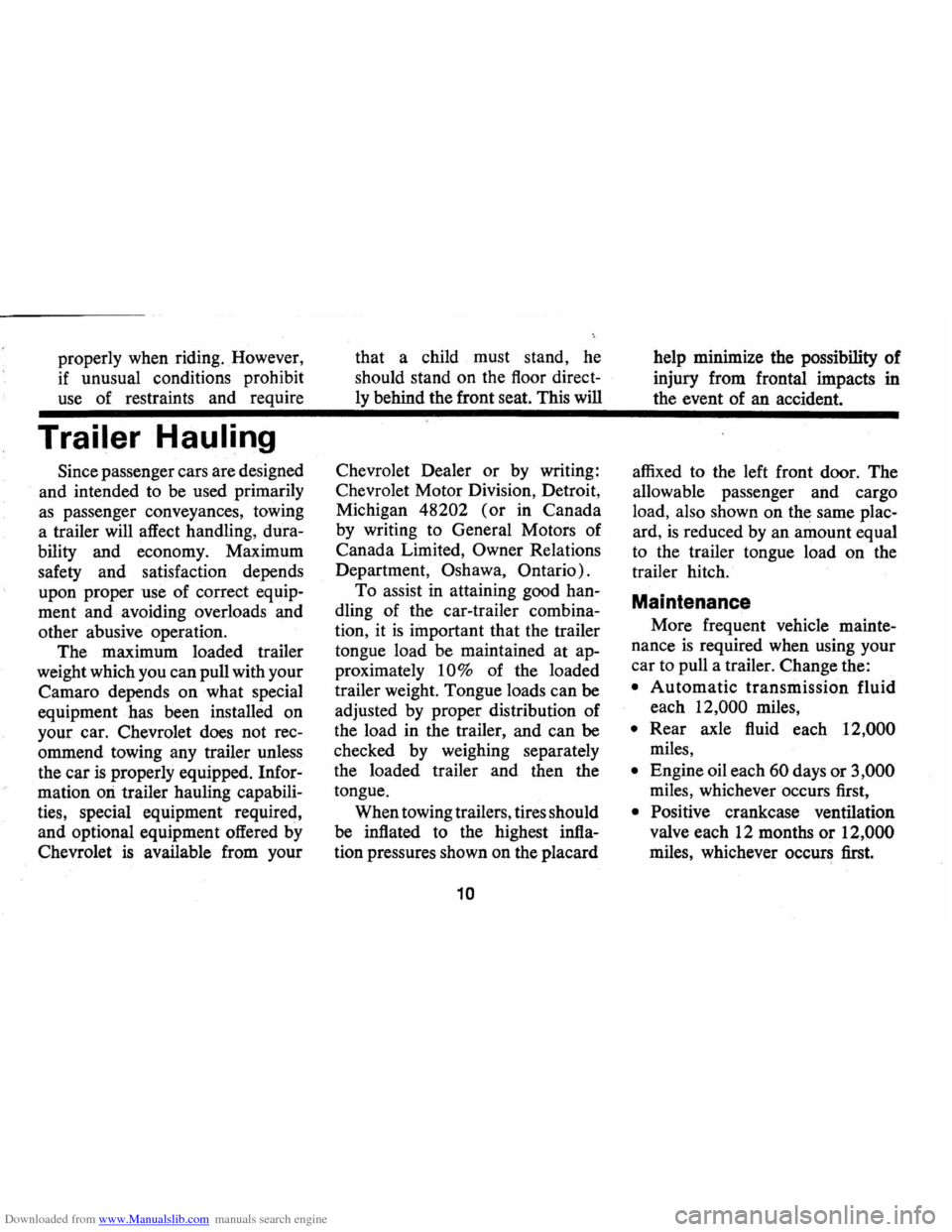
Downloaded from www.Manualslib.com manuals search engine properly when riding. However,
if unusual conditions prohibit
use of restraints and require
Trailer Hauling
Since passenger cars are designed
and intended to be used primarily
as passenger conveyances, towing
a trailer will affect handling, dura
bility and economy. Maximum
safety and satisfaction depends
upon proper use of correct equip
ment and· avoiding overloads and
other abusive operation.
The maximum loaded trailer
weight which you can pull with your
Camaro depends on what special
equipment has been installed on
your car. Chevrolet does not rec
ommend towing any trailer unless
the car
is properly equipped. Infor
mation
ori trailer hauling capabili
ties, special equipment required,
and optional equipment offered
by
Chevrolet is available from your that
a child must stand,
he
should stand on the floor direct
ly behind the front seat. This will
Chevrolet Dealer or by wntmg:
Chevrolet Motor Division, Detroit,
Michigan 48202
(or in Canada
by writing to General Motors of
Canada Limited,
Owner Relations
Department,
Oshawa, Ontario).
To assist
in attaining good han
dling of the car-trailer combina
tion, it
is important that the trailer
tongue load be maintained at ap
proximately 10% of the loaded
trailer weight. Tongue loads can
be
adjusted by proper distribution of
the load in the trailer, and can
be
checked by weighing separately
the loaded trailer and then the
tongue.
When towing trailers, tires should
be inflated to the highest infla
tion pressures shown on the placard
10
help minimize the possibility of
injury from frontal impacts in
the event of an accident.
affixed to the left front door. The
allowable passenger and cargo
load, also shown on the same plac
ard,
is reduced by an amount equal
to the trailer tongue load on the
trailer hitch.
Maintenance
More frequent vehicle mainte
nance
is required when using your
car to pull a trailer. Change the:
• Automatic transmission fluid
each
12,000 miles,
• Rear axle fluid each 12,000
miles,
• Engine oil each 60 days or 3,000
miles, whichever occurs first,
• Positive crankcase ventilation
valve each 12 months or
12,000
miles, whichever occurs first.
Page 14 of 84
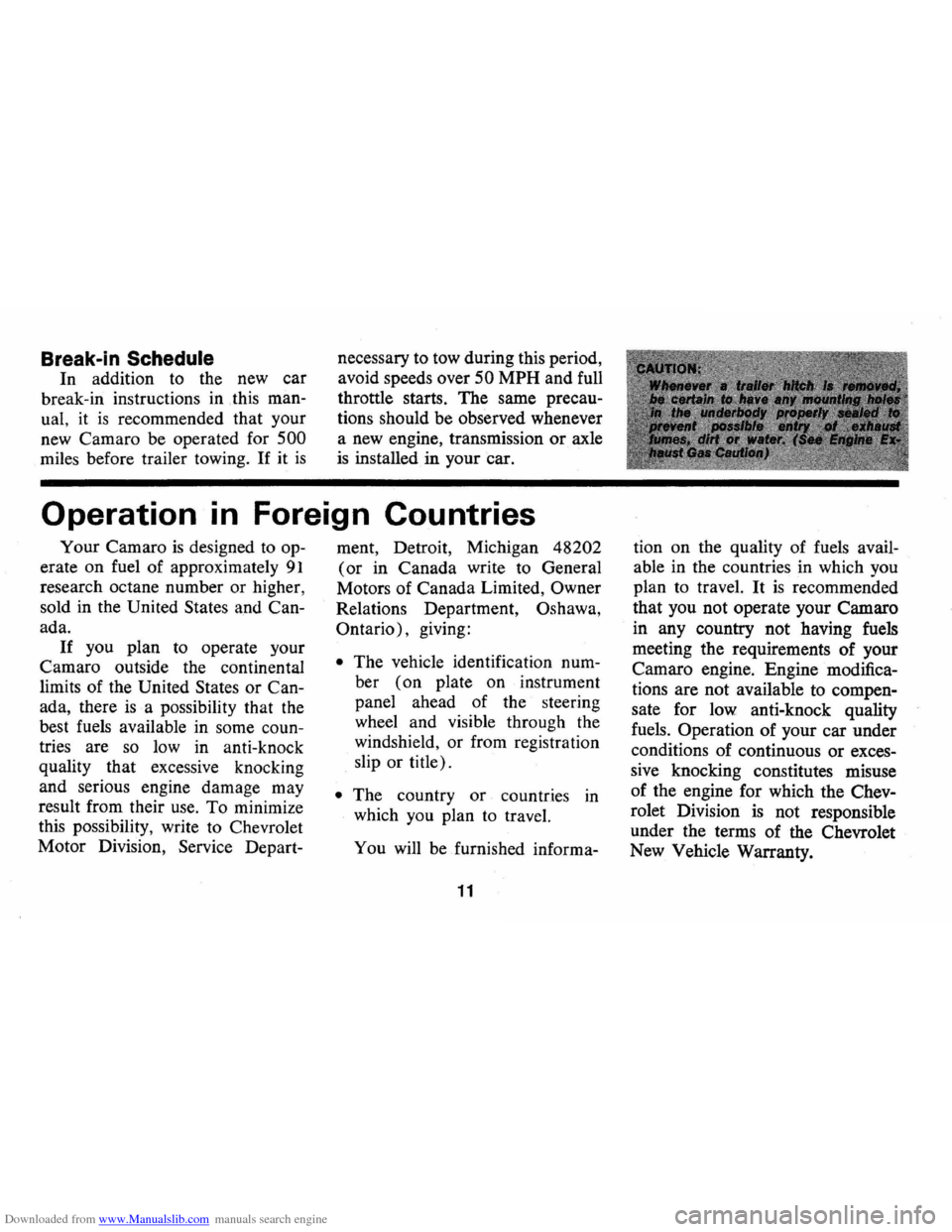
Downloaded from www.Manualslib.com manuals search engine Break-in Schedule
In addition to the new car
break-in instructions in this man
ual, it
is recommended that your
new Camaro be operated for
500
miles before trailer towing. If it is
necessary to tow during this period,
avoid speeds over
50 MPH and full
throttle starts. The same precau
tions should be observed whenever
a new engine, transmission
or axle
is installed in your car.
Operation in Foreign Countries
Your Camaro is designed to op
erate on fuel of approximately
91
research octane number or higher,
sold in the United
States and Can
ada.
If you plan to operate your
Camaro outside the continental
limits of the United
States or Can
ada, there
is a possibility that the
best fuels available in some coun
tries are
so low in anti-knock
quality that excessive knocking
and serious engine damage may
result from their
use. To minimize
this possibility, write to Chevrolet
Motor Division, Service Depart- ment,
Detroit, Michigan 48202
(or in Canada write to General
Motors of Canada Limited,
Owner
Relations Department, Oshawa,
Ontario),
giving:
• The vehicle identification num
ber ( on plate on instrument
panel ahead of the steering
wheel and visible through the
windshield, or from registration
slip or title).
• The country or countries in
which you plan to travel.
You
will be furnished informa-
11
tion on the quality of fuels avail
able in the countries in which you
plan to travel.
It is recommended
that you not operate your Camaro
in any country not having fuels
meeting the requirements
of your
Camaro engine. Engine modifica
tions are not available to compen
sate for low anti-knock quality
fuels. Operation of your car under
conditions of continuous
or exces
sive knocking constitutes misuse
of the engine for which the Chev
rolet Division
is not responsible
under the terms of the Chevrolet
New Vehicle Warranty.
Page 16 of 84
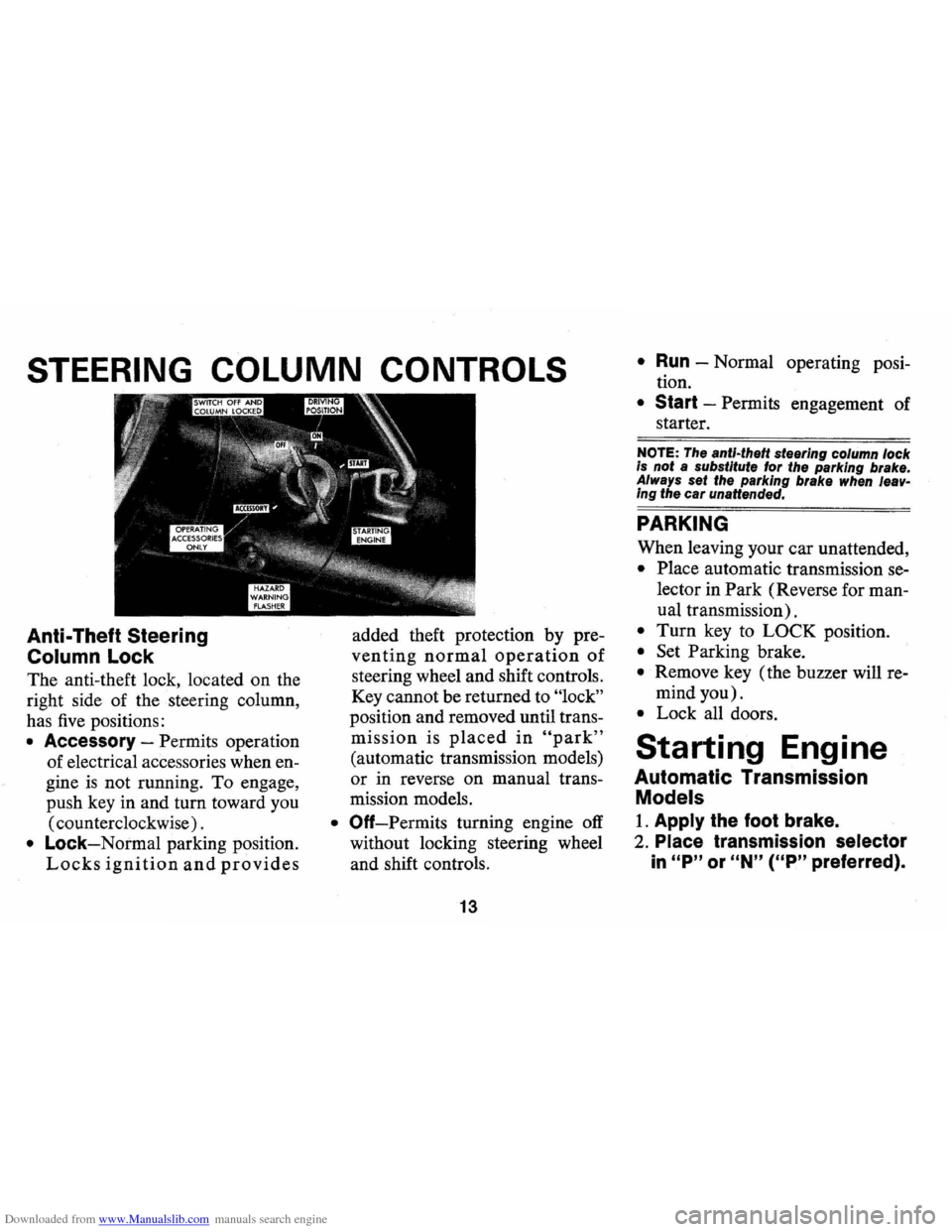
Downloaded from www.Manualslib.com manuals search engine STEERING COLUMN CONTROLS
Anti-Theft Steering
Column Lock
The anti-theft lock, located on the
right side of the steering column,
has
five positions:
• Accessory -Permits operation
of electrical accessories when en
gine
is not running. To engage,
push key in and turn toward you
( counterclockwise) .
• Lock-Normal parking position.
Locks ignition and provides
added theft protection by pre
venting normal operation of
steering wheel and shift controls.
Key cannot be returned to
"lock"
position and removed until trans
mission is placed in "park"
(automatic transmission models)
or in reverse on manual trans
mission models.
• Off-Permits turning engine off
without locking steering wheel
and shift controls.
13
• Run -Normal operating posi
tion.
• Start -Permits engagement of
starter.
NOTE: The anti-theft steering column lock Is not a substitute lor the parking brake.
Always set the parking brake when leaving the car unattended.
PARKING
When leaving your car unattended,
• Place automatic transmission se
lector in Park (Reverse for man
ual transmission).
• Turn key to LOCK position.
• Set Parking brake.
• Remove key (the buzzer will re
mind you).
• Lock all doors.
Starting Engine
Automatic Transmission
Models
1. Apply the foot brake.
2. Place transmission selector
in "P" or "N" (UP" preferred).
Page 28 of 84

Downloaded from www.Manualslib.com manuals search engine • Stopping distances may be
greater.
• Greater pedal effort may be re
quired .
• Pedal travel may be greater.
3.
Tryout brake operation by
starting and stopping on road
shoulder-then:
• If you judge such operation to
be safe, proceed cautiously at a
safe speed to nearest dealer for
repair.
• Or have car towed to dealer for
repair.
Continued operation of the car
in this condition
is dangerous.
Headlight Beam Indicator
Light
The headlights of your car have
high and low
beams to provide you with
proper night-time visibility
for most driving conditions. The
"low" beams are used during most
city driving. The
"high" beams are
especially useful when driving on
dark roads since
they' provide ex
cellent long range illumination.
The headlight beam indicator will
be on whenever the high beams
or
"brights" are in use. The Headlight
Beam Switch controls the headlight
beams (see Page
21).
Light Switch
The three position light switch
controls the headlights, taillights,
parking lights, side marker lights,
instrument lights and dome lights
as shown. The headlamp circuit is
protected by a circuit breaker in the
light switch.
An overload on the
breaker will cause the lamps to
"flicker" on and off. If this condi
tion develops, have your headlamp
wiring checked immediately.
PARKING LAMPS MARKER LAMPS TAIL AND INSTRUMENT LIGHTS
TURN KN08 TO VARY INSTRUMENT LIGHTS FUll Y COUNTER CLOCKWISE FOR DOME LIGHTS
25
HEADLIGHTS
PARKING LAMPS MARKER LAMPS
Page 34 of 84

Downloaded from www.Manualslib.com manuals search engine no matter which position the fan
switch
is in.
Temperature (Lower Level)
The temperature lever allows a
selection of air temperature from
Cold at the far left to Hot at the
far right. When the temperature
lever
is in the COLD position the
system will provide the coldest air
possible. When the temperature
lever
is moved to the right (toward
HOT), the system will operate on
outside air.
Selector (Upper Lever)
This lever provides a selection of
systems available to handle various
heating and cooling requirements
throughout the year. The Selector
lever has four
(4) major opera- tiona!
positions-"Off,"
"Air Con
ditioning," "Vent" and "Heating."
The "Air Conditioning" and "Heat
ing"
groups have several positions
which improve the effectiveness of
the system for various demands.
OFF-The system. operates on low
blower regardless of fan switch
position with air discharged into
vehicle through heater outlet.
A/C-Air from the passenger com
partment is recirculated through
the system with some outside air
and discharged from the upper
outlets when the temperature lever
is in Full COLD or extreme left. If
the Temperature lever is moved
right to the first stop or further,
the system will automatically go
on outside air. The
AIC position,
with Temp. lever in Full
COLD,
31
is used when maximum cooling is
required under conditions of high
temperature and humidity. High
fan speed
is automatically attained
in this position.
A/C(with Temp lever right to first
stop
)-Outside air is passed through
the system and discharged through
the upper outlets. This position
is
recommended for most air condi
tioning situations because of
re
duced blower noise and reduction
of cigarette smoke within the
vehicle.
Fan speed may be varied
as required.
VENT -Outside air is passed
through the system and discharged
from the upper and lower outlets.
This position
is provided for cool
to moderate weather when refrig
eration
is not required.
Page 39 of 84
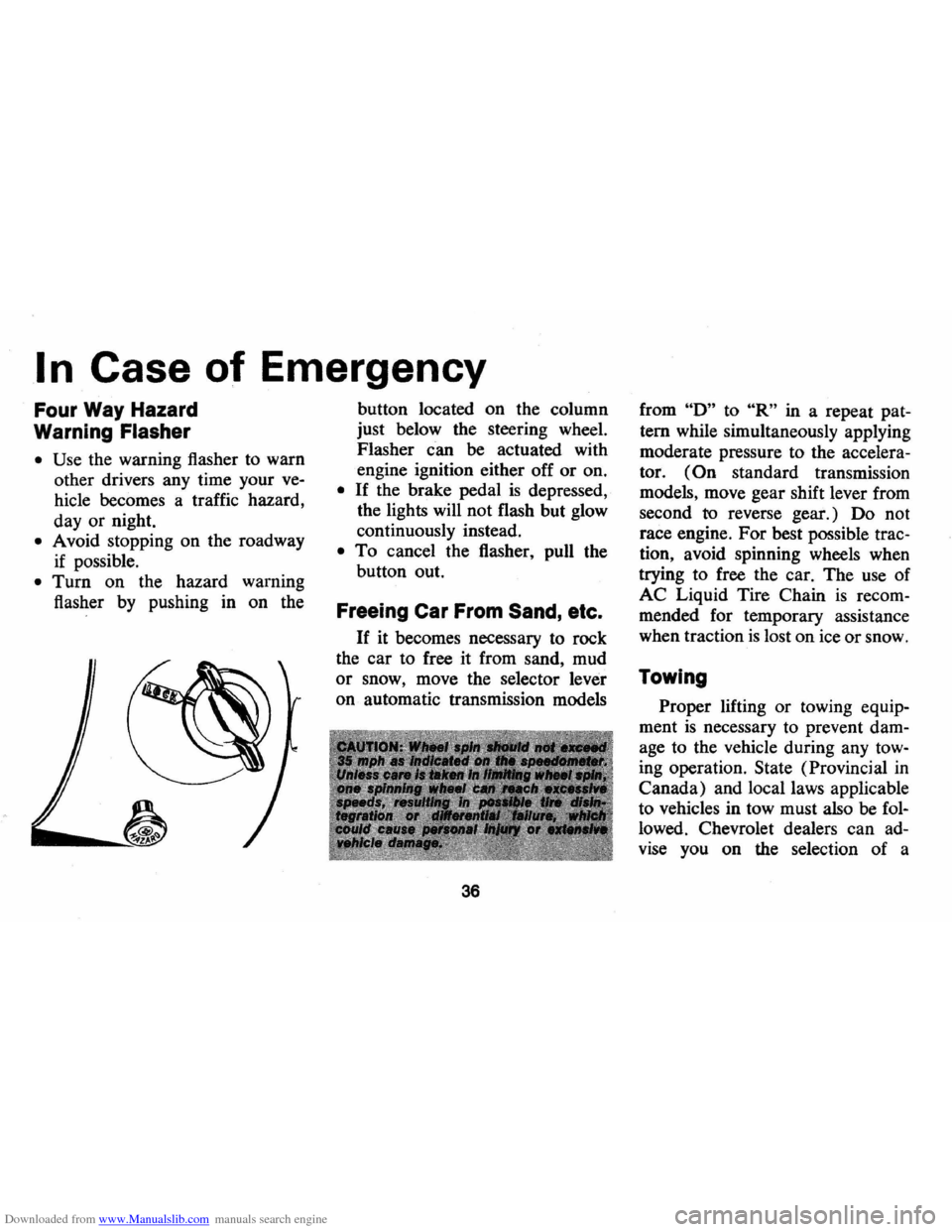
Downloaded from www.Manualslib.com manuals search engine .1 n Case of Emergency
Four Way Hazard
Warning Flasher
• Use the warning flasher to warn
other drivers any time your
ve·
hicle becomes a traffic hazard,
day or night.
• Avoid stopping on the roadway
if possible.
• Turn on the hazard warning
flasher
by pushing in on the
.---~
button located on the column
just below the steering wheel.
Flasher can be actuated with
engine ignition either off or on.
• If the brake pedal is depressed,
the lights will not flash but glow
continuously instead.
• To cancel the flasher, pull the
button out.
Freeing Car From Sand, etc.
If it becomes necessary to rock
the car to free it from sand, mud
or snow, move the selector lever
on automatic transmission models
36
from "0" to "R" in a repeat pat·
tern while simultaneously applying
moderate pressure to the
accelera
tor. (On standard transmission
models, move gear shift lever from
second
to reverse gear.) 00 not
race engine.
For best possible trac
tion, avoid spinning wheels when
trying to free the car. The use of
AC Liquid Tire Chain is recom
mended for temporary assistance
when traction
is lost on ice or snow.
Towing
Proper lifting or towing equip
ment is necessary to prevent dam
age to the vehicle during any tow
ing operation. State (Provincial in
Canada) and local laws applicable
to vehicles in tow must also be
fol
lowed . Chevrolet dealers can ad
vise you on the selection of a
Page 40 of 84
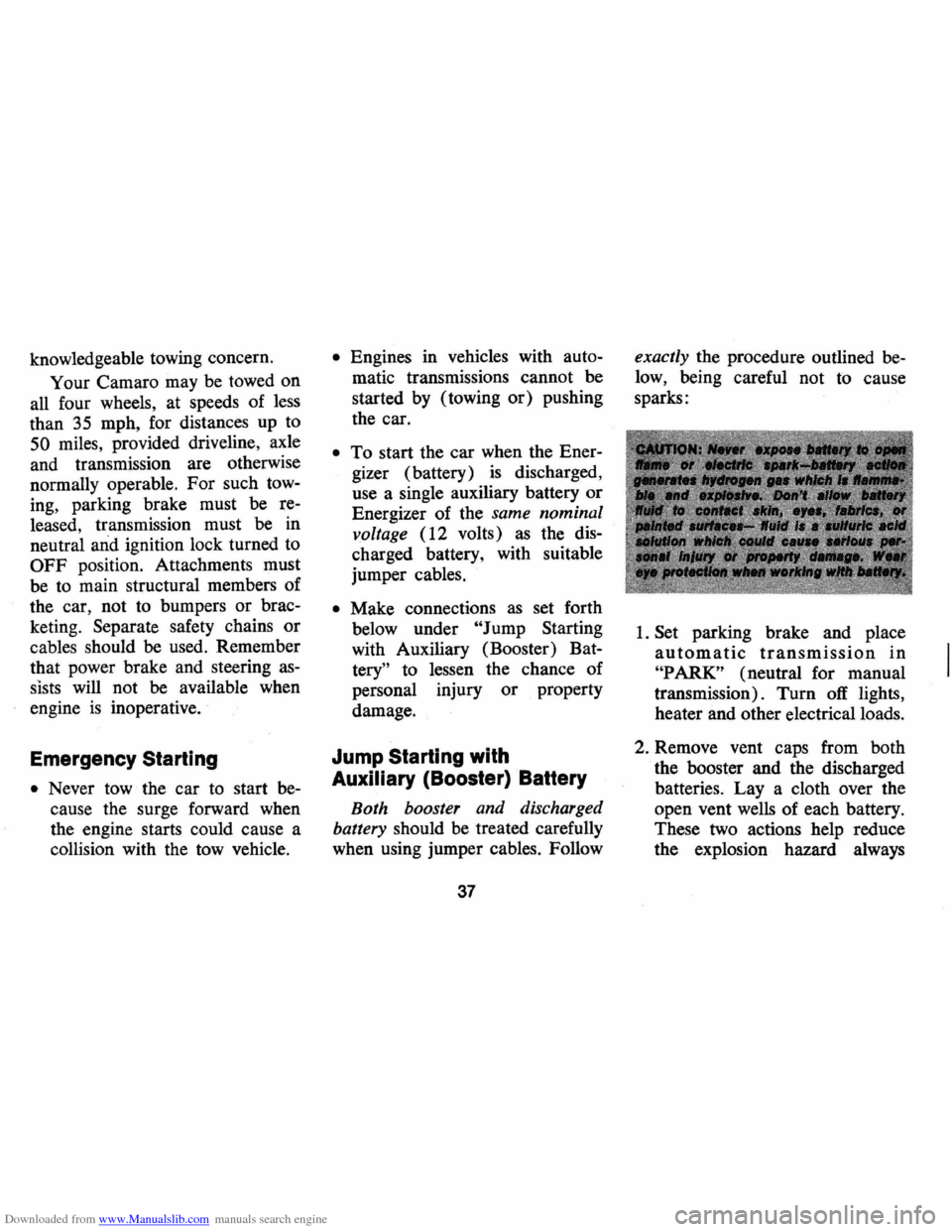
Downloaded from www.Manualslib.com manuals search engine knowledgeable towing concern.
Your Camaro may be towed on
all four wheels, at speeds of
less
than 35 mph, for distances up to
50 miles, provided driveline, axle
and transmission are otherwise
normally operable. For such tow
ing, parking brake must be re
leased, transmission must be in
neutral
and ignition lock turned to
OFF position. Attachments must
be to main structural members of
the car, not to bumpers or brac
keting. Separate safety chains
or
cables should be used. Remember
that power brake and steering
as
sists will not be available when
engine
is inoperative.
Emergency Starting
• Never tow the car to start be
cause the surge forward when
the engine starts could cause a
collision with the tow vehicle.
• Engines in vehicles with auto
matic transmissions cannot be
started by (towing
or) pushing
the car.
• To start the car when the Ener
gizer (battery)
is discharged,
use a single auxiliary battery or
Energizer of the same nominal
voltage
(12 volts) as the dis
charged battery, with suitable
jumper cables.
• Make connections as set forth
below under
"Jump Starting
with Auxiliary (Booster) Bat
tery" to lessen the chance of
personal injury
or property
damage.
Jump Starting with
Auxiliary (Booster) Battery
Both booster and discharged
battery should be treated carefully
when using jumper cables. Follow
37
exactly the procedure outlined be
low, being careful not to cause
sparks:
1. Set parking brake and place
automatic transmission in
"PARK" (neutral for manual
transmission). Turn
off lights,
heater and other electrical loads.
2. Remove vent caps from both
the booster and the discharged
batteries. Lay a cloth over the
open vent wells of each battery.
These two actions help reduce
the explosion hazard always